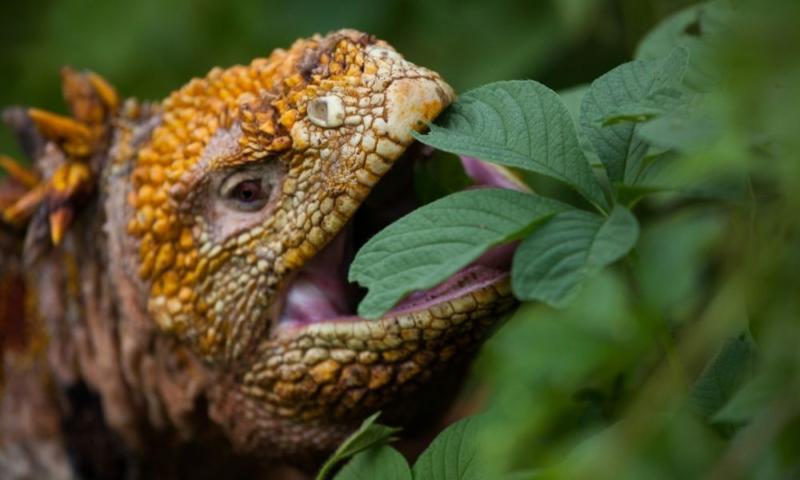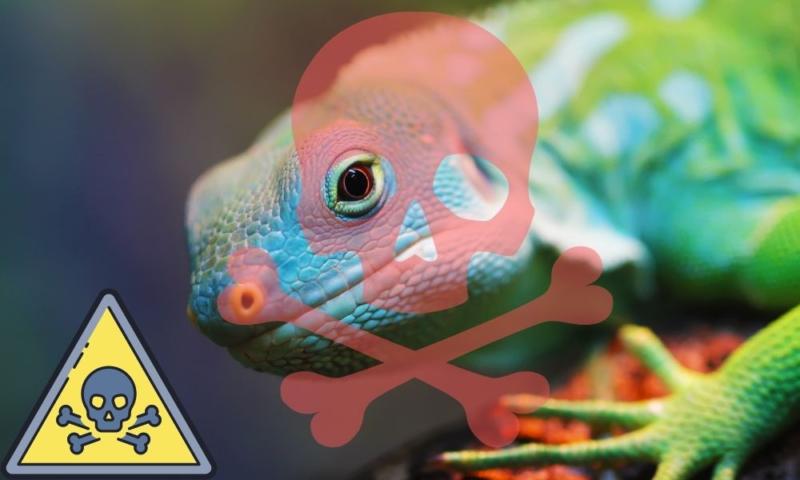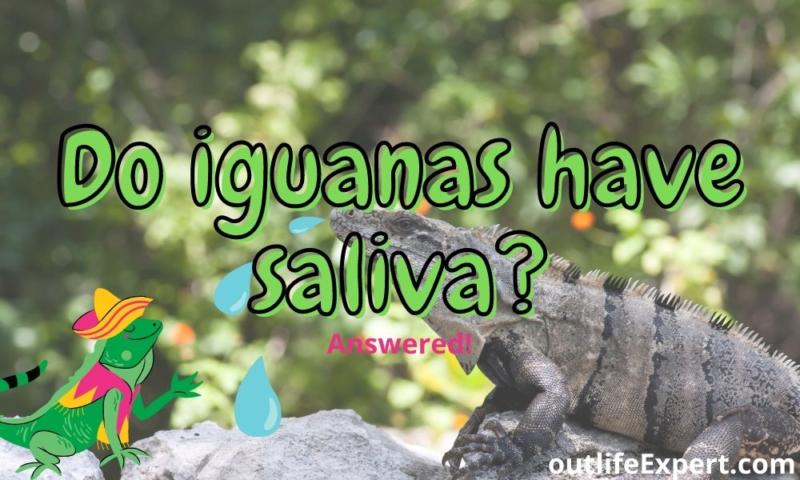You might have noticed that I recently wrote two blog posts on whether birds and fish make saliva. This time I will focus on reptiles, and one particularly interesting type: Iguanas!
Iguanas, like other reptiles, do have saliva, which appears clear when the lizard is healthy. But they do not use it to spit! Iguanas can produce large amounts of saliva that mostly helps to lubricate their food and facilitate swallowing, rather than aiding much enzymes to digestion as is the case for humans and other mammals.
Iguanas are a type of large reptile that live in the temperate southern region of North, Central, and South America, the Antilles, Galápagos Islands, Madagascar, Tonga, and Fiji.
Iguanas live on land, in trees, and rocks depending on the species. Iguanas are herbivores, specifically folivores, meaning they mostly eat leaves. Their diet is dependent on their habitat, but can include fruits, leafy plants, flowers, and insects.
Their saliva of Iguanas does not appear to have much proteolytic activity, which means their saliva lack digestion enzymes that help them break down food.
While Iguanas saliva is usually clear, mucus-like saliva that is cloudy, or pin-point hemorrhages (tiny spots of bruising) on the mucous membrane is not normal and a sign of disease.

There are 45 different species of iguana, which includes both land and marine iguanas. Marine iguanas are more social creatures, living in close body contact in large groups on the shore. Whereas land iguanas are more solitary by nature.
The iguana is a common pet for reptile collectors, and usually include one of five species:
- The green iguana (Iguana iguana)
- The desert iguana (Dipsosaurus dorsalis),
- The rhinoceros iguana (Cyclura cornuta),
- Black spiny tailed iguana (Ctenosaura similis),
- The grand Cayman or Blue iguana (Cyclura lewisi)
Do iguanas spit?
Generally, healthy iguanas do not spit or drool, as they don’t have a lot of saliva because of their need to conserve body fluids.
However, the marine iguana has a unique sneeze that allows them to remove excess salts from their bloodstream, ingested through their high salt seaweed and algae diet.
This is not spitting, as it is coming from out of the iguana’s nostrils and does not contain saliva, but a salty water mixture filtered from its blood.
The marine iguana (Amblyrhynchus cristatus), which is most relevant when it comes to saliva and body fluid excretions, is the only lizard in the world that has adapted to a marine lifestyle and can exclusively be found in the Galápagos Islands.
Although the marine iguana lives on land, it feeds in the sea, mostly grazing on seaweed. Most iguanas eat algae from rocks on the edge of the water, but larger males will swim out into the sea to find algae and seaweed.
They can dive 49 feet (15 m) below the surface of the water and can hold their breath for 5 to 10 minutes.
Iguanas are cold-blooded, which means that they don’t regulate their own body temperature, it varies with the environment they are in. Therefore, after swimming, they will sun themselves on the rocks to rewarm themselves.
Do iguanas sneeze and why?
Marine Iguanas use a certain mechanism, that may resemble a sneeze, to expel salts from their system.
However, there is some difference of opinion in whether iguanas’ unique behavior is considered a spit or a sneeze.
Marine iguanas feed on seaweed and algae underwater, and as a result take in a lot of salts (sodium, chloride, and potassium). Their food source, algae, is essentially soaked in salt.
Normally, the kidneys are responsible for regulating the salt and water levels in the blood, but to do this the kidneys require freshwater, which the iguana doesn’t have much of.
Urination isn’t enough to eliminate the excess salt from their bodies, so to prevent dehydration, they must remove the salt from their system in other ways while limiting their water loss.
Marine iguanas have specialized large cranial salt glands that is connected to their nostrils to help regulate their salt, chloride, and potassium levels to be able to remove the salt from their blood while leaving the water.
The salt from the bloodstream collects in this gland, located above the eyes, and connected to the nostril.
The ‘sneeze’ is the way marine iguanas expel the salt from their bodies, with a forceful expulsion. Since the gland is connected to their nostril, and not their mouth, I would consider this behavior a sneeze.
Sneezes can also be a reaction to remove a particle or object in the nose, just like humans. The sneeze can spray out and up several feet.
The marine iguanas are often seen with a white, crusty ‘wig’ on its head, as the sneeze can land on the iguana’s head, which then evaporates, leaving the layer of crusty salt.
So, in summary, because marine iguanas have a high intake of saltwater, they SNEEZE and don’t spit.
Some land iguanas have a similar salt gland, but these lizards have much less water and salt to regulate.
Is Iguana saliva poisonous?
Iguana saliva is generally not poisonous to humans, but some species do have venom glands in their mouths that produce a venom of low toxicity that is harmless to humans. However, they do often, unintentionally, carry bacteria in their mouth and on their body that may cause infections in humans.
To be clear, poison and venom are different things. While poison is a toxin that enters the body via swallowing, inhaling or absorption through the skin without active effort (like poison ivy), venom is a type of poison that has evolved with a specific purpose, like defence, and actively injected through a bite or a sting used by snakes and spiders.
The iguana species know to produce venom are:
- Iguanian Lizard (Pogona barbata)
- Green iguana (Iguana iguana)
- Rhinocerous iguana (Cyclura cornuta)
- Marine iguana (Amblyrhynchus cristatus)

For the venom to be effective, it must find its way into the bloodstream.
You are much more likely to be injured from the dozens of sharp, serrated teeth if the iguana bites you.
They can cause serious damage to the face, fingers, wrists, and ankles. Iguana bites are fairly uncommon, but warning signs of an iguana about to strike include: the iguana standing on all fours, lowering the animal’s dewlap (the skin flap under its chin), and drawing in a deep breath to make the body appear larger. But beware, because iguanas can strike without warning.
Despite their venom being harmless, iguanas are known to carry Salmonella and other bacteria on their skin, teeth, and intestinal tract, which can be passed to humans who have them as pets or others who are in close contact.
These bacteria are commonly passed through their feces, skin, and saliva. Young children and immunocompromised people are at the highest risk of Salmonella or other saliva transmitted bacterial infections, but anyone outside these groups can be infected.
Other bacterial or parasitic diseases that may be transmitted by iguana saliva include botulism (affecting nervous system), leptospirosis, campylobacteriosis (a bowel infection), and trichinellosis (a disease affecting the muscles and nervous system).
Conclusions
We have seen interesting cases where animals have lost their ability to produce saliva due to their time spend in water. This, however, is not the case for most lizards and even the Marine Iguanas still produce saliva although they mostly forage at sea.
And we have learned that although marine iguanas seem to spit or sneeze through their nostrils, this mechanisms is somewhat similar to our kidney functions and would not be considered saliva or snot.
Finally, Iguanas do produce venom in their mouth but their saliva is not a danger for humans. If you get bitten by an Iguana, you should worry more about the risk of infection that the venom their produce.
References
Fry et al. 2005. Early evolution of the venom system in lizards and snakes. Nature.
https://www.science.org.au/curious/people-medicine/poison-vs-venom
Books:
Reptile Medicine and Surgery 2nd Edition. 2005. by Stephen J. Divers, Douglas R. Mader
Iguanas: Biology and Conservation edited by Allison C. Alberts, Ronald L. Carter, William K. Hayes, Emilia P. Martin




